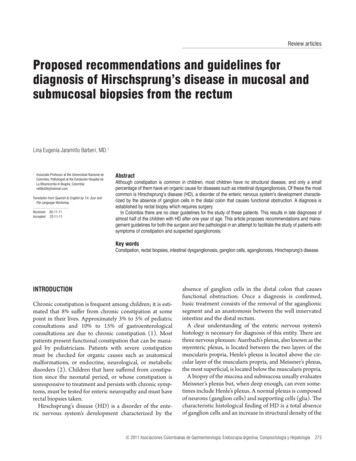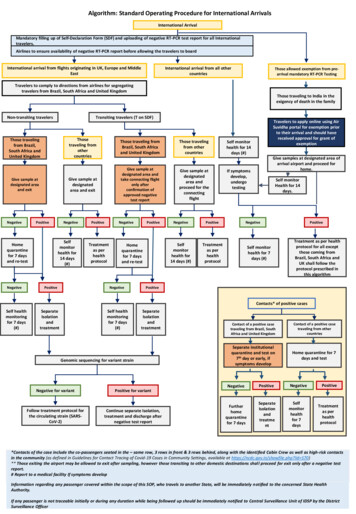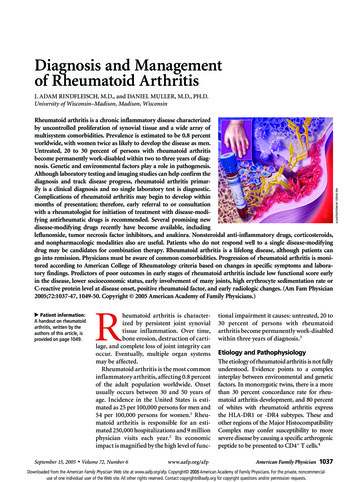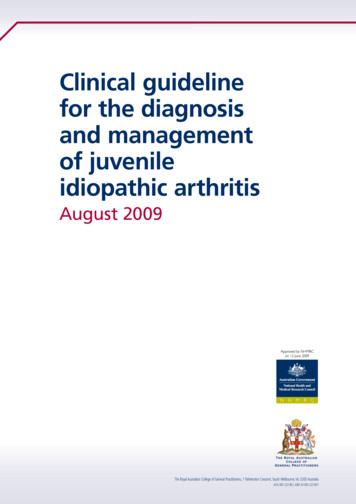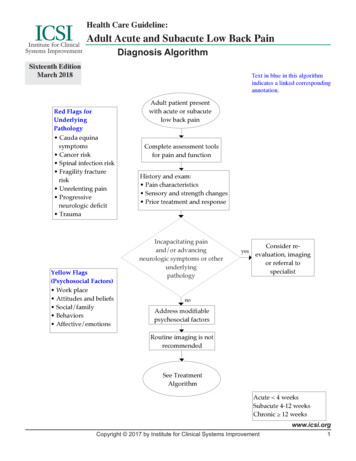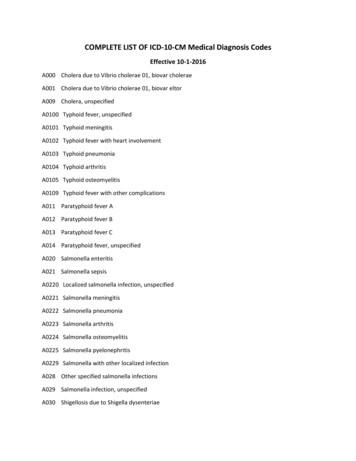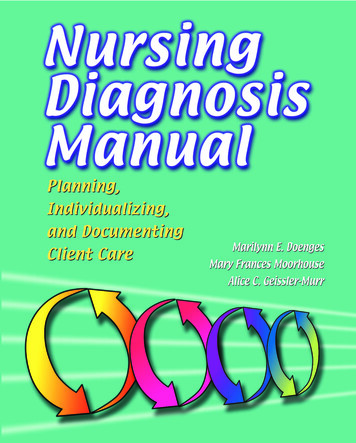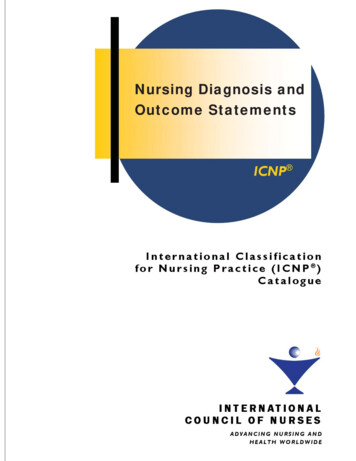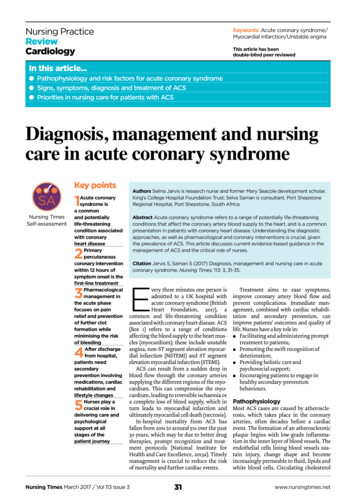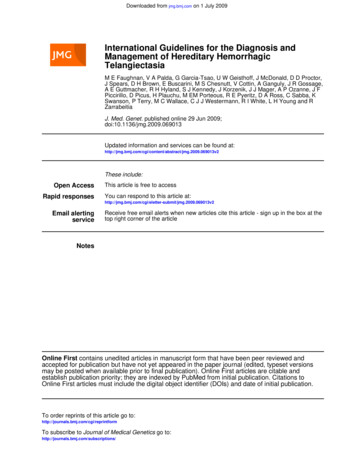
Transcription
Downloaded from jmg.bmj.com on 1 July 2009International Guidelines for the Diagnosis andManagement of Hereditary HemorrhagicTelangiectasiaM E Faughnan, V A Palda, G Garcia-Tsao, U W Geisthoff, J McDonald, D D Proctor,J Spears, D H Brown, E Buscarini, M S Chesnutt, V Cottin, A Ganguly, J R Gossage,A E Guttmacher, R H Hyland, S J Kennedy, J Korzenik, J J Mager, A P Ozanne, J FPiccirillo, D Picus, H Plauchu, M EM Porteous, R E Pyeritz, D A Ross, C Sabba, KSwanson, P Terry, M C Wallace, C J J Westermann, R I White, L H Young and RZarrabeitiaJ. Med. Genet. published online 29 Jun 2009;doi:10.1136/jmg.2009.069013Updated information and services can be found 9.069013v2These include:Open AccessRapid responsesThis article is free to accessYou can respond to this article 069013v2Email alertingserviceReceive free email alerts when new articles cite this article - sign up in the box at thetop right corner of the articleNotesOnline First contains unedited articles in manuscript form that have been peer reviewed andaccepted for publication but have not yet appeared in the paper journal (edited, typeset versionsmay be posted when available prior to final publication). Online First articles are citable andestablish publication priority; they are indexed by PubMed from initial publication. Citations toOnline First articles must include the digital object identifier (DOIs) and date of initial publication.To order reprints of this article go to:http://journals.bmj.com/cgi/reprintformTo subscribe to Journal of Medical Genetics go to:http://journals.bmj.com/subscriptions/
Downloaded from jmg.bmj.com on 1 July 2009JMG Online First, published on June 29, 2009 as 10.1136/jmg.2009.069013International Guidelines for the Diagnosis and Management ofHereditary Hemorrhagic TelangiectasiaM.E. Faughnan MD MSc1,2, V.A. Palda MD MSc3, G. Garcia-Tsao MD4, U.W. GeisthoffMD PhD5,6, J. McDonald MS CGC7, D.D. Proctor MD8, J. Spears MD MPH9, D.H.Brown MD10, E. Buscarini MD11, M.S. Chesnutt MD12, V. Cottin MD PhD13, A. GangulyPhD14, J.R. Gossage MD15, A.E. Guttmacher MD16, R.H. Hyland MD1, S.J. Kennedy MSCGC17, J. Korzenik MD18, J.J. Mager MD PhD19, A.P. Ozanne MD20, J.F. PiccirilloMD21, D. Picus MD22, H. Plauchu MD PhD23, M.E.M. Porteous MD24, R.E. Pyeritz MDPhD25, D.A. Ross MD26, C. Sabba MD27, K. Swanson DO28, P. Terry MD29, M.C.Wallace MD30, C.J.J. Westermann MD PhD19, R.I. White MD31, L.H. Young MD32 andR. Zarrabeitia MD33.1Division of Respirology, Department of Medicine, St. Michael’s Hospital, University ofToronto, Toronto, ON, Canada2Li Ka Shing Knowledge Institute, St. Michael’s Hospital, University of Toronto,Toronto, ON, Canada3Departments of Medicine, Health Policy, Management and Evaluation,University of Toronto, Toronto, ON, Canada4Section of Digestive Diseases, Department of Internal Medicine,Yale University Schoolof Medicine,New Haven, CT, USA5University of the Saarland, Medical Faculty, Homburg/Saar, Germany6Department of Otorhinolaryngology, Holweide Hospital, Hospitals of the City ofCologne, Cologne, Germany7Department of Radiology, University of Utah, Salt lake City, Utah.8Section of Digestive Diseases,Yale University School of Medicine, New Haven, CT,USA9Department of Surgery, St. Michael’s Hospital, University of Toronto, Toronto, Ontario,Canada10Dept of Otolaryngology/Head & Neck Surgery, University of Toronto, Toronto, ON,Canada11U.O di Gastroenterologia ed Endoscopia Digestiva, Ospedale Maggiore, Crema, Italy12Portland VA Medical Center, HHT Center of Excellence, Dotter InterventionalInstitute, Oregon Health & Science University13University of Lyon, Hospices Civils de Lyon, National reference center forrare pulmonary diseases, Lyon, France1Copyright Article author (or their employer) 2009. Produced by BMJ Publishing Group Ltd under licence.
Downloaded from jmg.bmj.com on 1 July 200914Department of Genetics, University of Pennsylvania School of Medicine, Philadelphia,PA, USA15Medical College of Georgia, Augusta, GA, USA16National Human Genome Research Institute, NIH, Bethesda, MD17Ontario Newborn Screening Program and Regional Genetics Program,Children's Hospital of Eastern Ontario, Ottawa, ON, Canada18Massachusetts General Hospital Gastrointestinal Unit, Boston, MA, USA19St. Antonius Hospital, Nieuwegein, the Netherlands20Interventional Neuroradiology, Hopital de Bicetre, Paris, France21Department of Otolaryngology-Head & Neck Surgery, Washington University Schoolof Medicine, St. Louis, MO, USA22Department of Radiology, Washington University School of Medicine.St Louis, MO, USA23National Reference Center for HHT Disease, Hotel Dieu Hospital, Hospices Civils deLyon, Lyon, France24SE Scotland Genetic Service, Western General Hospital, Edinburgh, Scotland25University of Pennsylvania School of Medicine, Philadelphia, PA, USA26Department of Surgery, St. Vincent's Medical Center, Bridgeport, CT, USA27Department of Internal Medicine and Public Health, University of Bari, Bari, Italy28Mayo Clinic Division of Pulmonary & Critical Care Medicine, Rochester, MN, USA29Division of Pulmonary & Critical Care Medicine, Johns Hopkins University, Baltimore,MD, USA30Division of Neurosurgery, Krembil Neuroscience Centre, University HealthNetwork, Toronto, ON, Canada31Yale Vascular Malformation Center, Yale University School of Medicine, NewHaven, CT, USA32Section of Cardiovascular Medicine, Yale University School of Medicine, NewHaven, CT, USA33Servicio de Medicina Interna, Unidad HHT,Hospital Sierrallana (Servicio Cántabro deSalud), Torrelavega (Cantabria), SpainWord count 5536Key Words:GuidelinesHereditary hemorrhagic telangiectasiaArteriovenous malformationTelangiectasiaEpistaxis2
Downloaded from jmg.bmj.com on 1 July 2009AbstractHHT is an autosomal dominant disease with an estimated prevalence of at least 1/5000which can frequently be complicated by the presence of clinically significantarteriovenous malformations in the brain, lung, gastrointestinal tract and liver. HHT isunder-diagnosed and families may be unaware of the available screening and treatment,leading to unnecessary stroke and life-threatening hemorrhage in children and adults.The goal of this international HHT guidelines process was to develop evidence-informedconsensus guidelines regarding the diagnosis of HHT and the prevention of HHT-relatedcomplications and treatment of symptomatic disease. The overall guidelines process wasdeveloped using the AGREE framework, using a systematic search strategy and literatureretrieval with incorporation of expert evidence in a structured consensus process wherepublished literature was lacking. The Guidelines Working Group included experts(clinical and genetic) from eleven countries, in all aspects of HHT, guidelinesmethodologists, health care workers, health care administrators, HHT clinic staff, medicaltrainees, patient advocacy representatives and patients with HHT. The Working Groupdetermined clinically relevant questions during the pre-conference process. The literaturesearch was conducted using the OVID MEDLINE database, from 1966 to October 2006.The Working Group subsequently convened at the Guidelines Conference to partake in astructured consensus process using the evidence tables generated from the systematicsearches. The outcome of the conference was the generation of 33 recommendations forthe diagnosis and management of HHT, with at least 80% agreement amongst the expertpanel for 30 of the 33 recommendations.3
Downloaded from jmg.bmj.com on 1 July 2009IntroductionHHT is an autosomal dominant disease with an estimated prevalence of 1/5000[1] and isthought to be present in all races and parts of the world. Though epistaxis is the mostcommon symptom of HHT and mucocutaneous telangiectasia the most common sign[2],HHT is also frequently complicated by the presence of arteriovenous malformations(AVMs) in the brain, lung, gastrointestinal (GI) tract and liver.Unfortunately, HHT is often not diagnosed and entire families therefore remain unawareof available screening and treatment, and children and adults unnecessarily developstroke or life-threatening hemorrhage. The goal of the international HHT guidelinesprocess was to develop evidence-based consensus guidelines for the diagnosis of HHT,the prevention of HHT-related complications and treatment of symptomatic disease.MethodsThe overall guidelines process (Figure) was developed using the AGREE framework [3]with guidelines methodologists. The structure was that of a systematic evidence-basedprocess with incorporation of expert evidence in a structured consensus process whereevidence was lacking. We expected only weak or poor evidence in most areas, but chosethis approach to maximize quality and applicability of the guidelines and provide afoundation for future research and guidelines in HHT.Determination of Need for GuidelinesThe need for clinical guidelines for HHT was identified by the HHT FoundationInternational, an international advocacy group for people with HHT, and theFoundation’s Scientific and Medical Advisory Board. This was based on their consistentobservations of care gaps in HHT, specifically that HHT is under-diagnosed, that thereare frequent delays in diagnosis and that most patients and families with HHT are notreceiving appropriate preventative treatment. No clinical guidelines were in place for themulti-system manifestations of the disorder, with the exception of the recently publishedguidelines for liver vascular malformations (VMs)[4].Membership of the HHT Guidelines Working GroupAn organizing committee of clinicians, scientists, methodologists, patients andFoundation members selected the members of the HHT Guidelines Working Group. Thisincluded experts (clinical and genetic) from eleven countries, in all aspects of HHT,guidelines methodologists, health care workers and administrators, HHT Foundationrepresentatives and patients with HHT. Each member was also a member of a topicsubgroups [diagnosis, epistaxis, cerebral vascular malformations (CVMs), pulmonaryAVMs (PAVMs), GI bleeding and liver VMs]. Patients contributed to the developmentof the clinically relevant questions and the recommendations, with particular inputregarding values around recommendations.4
Downloaded from jmg.bmj.com on 1 July 2009Determination of Clinically Relevant QuestionsDuring the pre-conference process, the topic subgroups worked by email to developclinically relevant questions. The subgroups circulated and edited these through severaliterations. These formed the basis for the literature review.Background PreparationA literature search was conducted using the OVID MEDLINE database from 1966 toOctober 2006 to identify relevant English-language publications, using the searchstrategies as outlined in Appendix I. Hand searches of relevant articles and reviews werealso done for each clinically relevant question. Bibliographies of retrieved publicationswere reviewed to identify sources not obtained in our search. Publications in abstractform were included to minimize publication bias. One author (MEF) and the literaturereview assistant (J. Silver) independently reviewed abstracts and any relevant studieswere pulled for review. Inclusion and exclusion criteria for study selection are listed inAppendix I. Results from selected studies were extracted into evidence tables, and alongwith original papers, were sent to participants for review, and to determine if any relevantliterature was missing.Determination of Clinical RecommendationsParticipants convened at the Guidelines Conference to partake in a structured consensusprocess using the evidence tables. With the assistance of professional guidelinesfacilitators, topic subgroups prioritized clinically relevant questions and then generatedrecommendations for these. All participants assembled together afterwards to vote for allgenerated recommendations. Those recommendations achieving less than 80% agreementwere further discussed, revised again with a facilitator, and re-voted. Wording ofrecommendations was considered final and are presented with the % agreement obtainedon the final vote. Priorities for future research were also identified during the process(Appendix II).Grading of evidenceEach recommendation was graded to indicate the level of evidence available using theclassification system of the Canadian Task Force on the Periodic Health Examination [5](Table 1). In addition, values around recommendations were generated using theGRADE instrument [6, 7] and these were reported as “strength of the recommendation”.The “strength of the recommendation” incorporated evidentiary and non-evidentiaryfactors, including baseline risks of outcomes, benefits of treatment, potential harms oftreatment, certainty of point estimates, levels of evidence. Values were also incorporated,such as the importance of certain outcomes to stakeholders and other factors such asavailability of certain tests, for example.General OrganizationThe pre-conference process occurred by email over six months leading up to the two-dayGuidelines Conference near Toronto, Canada, in November 2006. The Conference washeld in a facility with anonymous key pad voting technology. The large group sessionswere recorded (audio) and minuted.5
Downloaded from jmg.bmj.com on 1 July 2009Preparation of ReportTopic leaders generated each area of the manuscript, which was then revised by MEF, VPand the topic members for each group, and then reviewed by the other authors. Theliterature search referenced was that obtained in October 2006. At the time of finalmanuscript review, two steps were taken to assure that no generated recommendationneeded immediate revision. First, a literature search for any interim RandomizedControlled Trials in HHT was performed, which revealed none. Secondly, the WorkingGroup was polled for knowledge of any recent publications that would lead to asignificant change in any of
2 14Department of Genetics, University of Pennsylvania School of Medicine, Philadelphia, PA, USA 15Medical College of Georgia, Augusta, GA, USA 16National Human Genome Research Institute, NIH, Bethesda, MD 17Ontario Newborn Screening Program and Regional Genetics Program, Children's Hospital of Eastern Ontario, Ottawa, ON, Canada 18Massachusetts General Hospital Gastrointestinal
